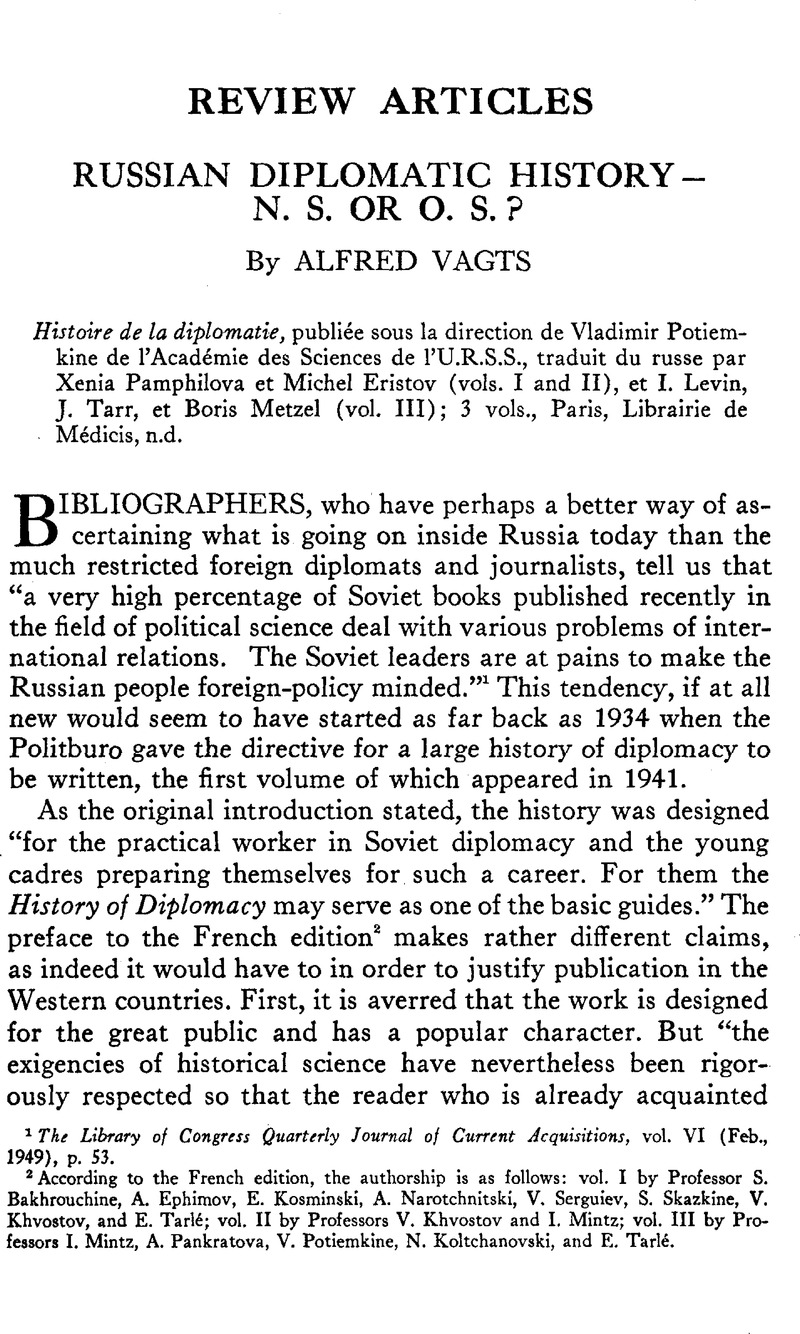No CrossRef data available.
Article contents
Russian Diplomatic History—N. S. or O. S.?
Published online by Cambridge University Press: 18 July 2011
Abstract

- Type
- Review Article
- Information
- Copyright
- Copyright © Trustees of Princeton University 1949
References
1 The Library of Congress Quarterly Journal of Current Acquisitions, vol. VI (Feb., 1949), p. 53.
2 According to the French edition, the authorship is as follows: vol. I by Professor S. Bakhrouchine, A. Ephimov, E. Kosminski, A. Narotchnitski, V. Serguiev, S. Skazkine, V. Khvostov, and E. Tarlé; vol. II by Professors V. Khvostov and I. Mintz; vol. III by Professors I. Mintz, A. Pankratova, V. Potiemkine, N. Koltchanovski, and E. Tarlé.
3 There are documents from as early as 1200 B.C., and as late as 1939. The bibliography for the most part, stops at 1942, although there is one item from 1945.
4 UP dispatch from Moscow, May 11, 1949.
5 Cf. C. E. Black in The American Slavic and Eastern European Review, Oct., 1948, pp. 276 ff., and B. Elkin in Slavonic and East European Review, April 1947, pp. 569 ff.
6 Posomby is Ponsonby; Niemann is Neumann (I, 418); Stockman is Stockmar (I, 426); Suard is Seward (I, 461); Gansemann is Hansemann; Lyard is Layard on one occasion (II, 47) and Lairds on another (I, 464); Hertzberger is Erzberger; Curr, Hankee and Nox (III, 73–74) are Kerr, Hankey and Knox; Heisler is Gessler (III, 103); Mawlton is Mouiton (III, 135); Gösch is Hoesch and Heinlein, Henlein and Colonel Swine (III, 769) is Swaine. Aehrenthal is transcribed as Ehrenthal (Honor Valley), which of course omits the family history behind the name Aehrenthal, which refers to the grain trade in which the family fortune was made.
7 Or Corti in Corthis (II, 54), Oubril in Oubry (II, 63), Cave in Kayves (II, 73), Currie in Kerry (II, 93), Beit in Beight (II, 132) and the British generals Poole and Dunsterville in Poul and Densterwill (II, 409 and 414) or Philip Lloyd Greame in Lloyd Grimm (III, 209). Mignier is the historian Mignet (I, 243), Thomas Penn is Paine (I, 338), Lisol (I, 171) is Lisola, Vikford is Wicqfort whose handbook The Ambassador did not appear in 1778 but in 1681 (I, 169). The Hohenlohe mentioned on II, 181, is actually a Hohenau, the Crewe on II, 195, a Crowe (Sir Eyre); the grand-duke mentioned on II, 241 and II, 268 is an archduke (Francis Ferdinand), the lord Runciman (III, 648) a viscount; Bismarck was not yet a count when ambassador to Russia (I, 473) and not an East Prussian (I, 481). The Dutchman Baltassar Hayala, author of De jure belli et officiis bellicis of 1582 (I, 167) is the Spaniard Ayala. The Hohenzollern in the beginning of the XVth century were not princes but simple counts (I, 251); Bernadotte was never Charles, but Jean Baptiste, as long as he was Bernadotte (I, 367).
8 Geyer, Curt, Drei Verderber Deutschlands, Berlin, Dietz, 1924.Google Scholar
9 Mayer, Gustav, Friedrich Engels, 2 vols., Berlin, 1920, vol. II, pp. 460–61.Google Scholar
10 Ross, M., A History of Soviet Foreign Policy, New York, Workers Library Publishers, 1940, p. 44.Google Scholar
11 Mayer, , op. cit., vol. II, p. 479.Google Scholar
12 Engels to Marx, April 27, 1867, in Marx, Karl and Engels, Friedrich, Historisch-Kritische Gesamtausgabe, 12 vols., Frankfurt a. M., 1927–1935, vol. III, Dritte Abteilung, p. 387.Google Scholar
13 Schuman, Frederick L., Soviet Politics, at Home and Abroad, New York, A. A. Knopf, 1946, p. 51.Google Scholar
14 Dallin, David J., The Big Three, New Haven, Yale, 1945, p. 84.Google Scholar
15 See the Peace Treaty of April 14, 1686, between Ivan and Peter, Czars of Muscovy, and King John of Poland; Dumont, Jean, Corps universel diplomatique du droit des gens …, 8 vols., Amsterdam, 1726–1731, vol. II, Part 2, p. 125.Google Scholar
16 To put the odium on the aggressor even more strongly, it is maintained that as a rule in diplomacy a declaration of war must precede hostilities and that the Japanese broke that rule when they attacked the Chinese in 1894 (II, 124), or the Russian fleet at Port Arthur in 1904. Actually, only some ten wars of the 120 that took place between 1700 and 1872 were preceded by formal declarations. SirMaurice, J. F., Hostilities without Decla ration of War, London, 1883.Google Scholar
17 For such a case, that of Soviet ambassador Helfand in Rome, 1940, see Gibson, Hugh, ed., The Ciano Dianes, 1939–1943, Garden City, Doubleday, 1946, pp. 275–6.Google Scholar
18 Pobiédonostsev, Constantine, Mémoires, politiques, correspondance officielle, …, Paris, 1927, p. 489.Google Scholar
19 Mme. Kollontai, Soviet Minister to Sweden, a writer in her own right, in October, 1939, had to protest to the Swedish foreign office against an article in Social-Demokraten, which cited as a commentary on the fourth division of Poland Voltaire's letter to Catherine II of 1772: “Have you, like other thieves, immediately begun to divide the spoils?” UP dispatch from Stockholm, Oct. 7, 1939.


